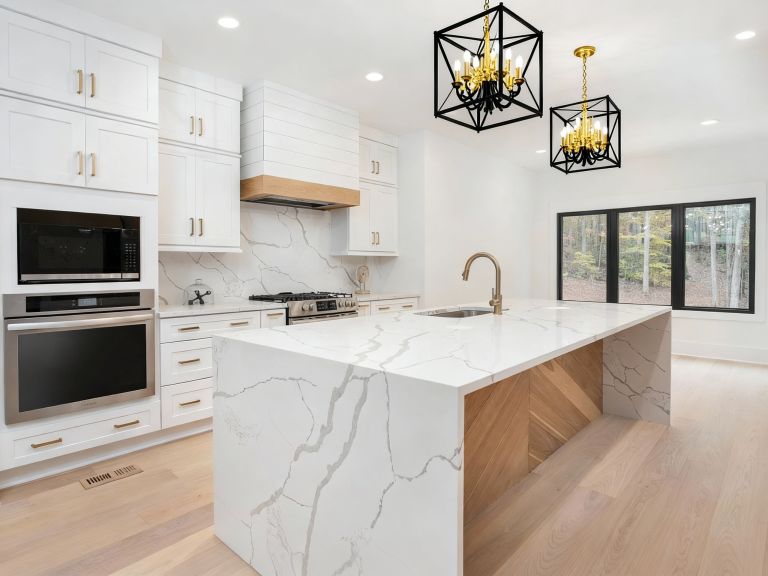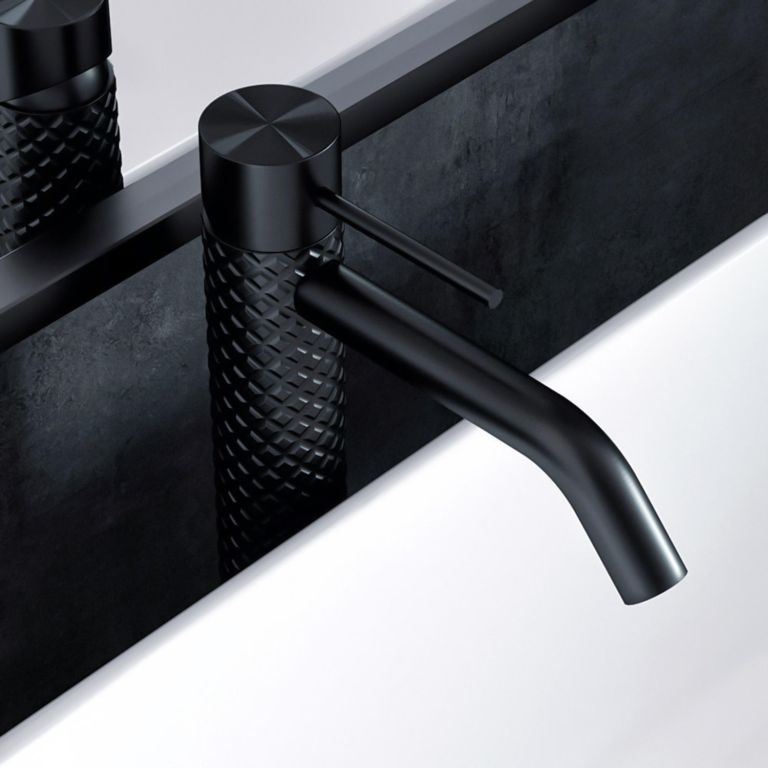Read on for all the pros and cons to keep in mind for an educated decision about installing a kitchen sink.
Even if you’re not an avid cook or baker, your kitchen sink is still a heavily used fixture. From washing hands to cleaning dishes, your sink plays an essential role in the function and design of your kitchen. Ahead, we tackle the pros and cons of the basic types of sinks—both in terms of installation type and configuration.
Installation Types
There are essentially three different types of sinks, each installed in a different way: top-mount sinks, undermount sinks, and flush-mount sinks.
Top-Mount Sinks (Self-Rimming or Drop-In Sinks)
As the most common type of kitchen sink, the top-mount sink is installed by inserting the sink into a pre-cut hole in the countertop. The wide rim around the sink supports it on top of the countertop, and is then caulked in place with silicone for a water-tight fit.
Pros: These sinks are very easy to install because they simply slide into place before being caulked. Because they’re the most common type of sink, they’re easy to find, even at big box stores, and they’re typically available at a lower price point than undermount or flush-mount sinks.
Cons: However, drop-in sinks have some functional as well as aesthetic drawbacks. Because the lip of the sink is exposed, it’s not possible to sweep food or liquid directly into the sink, making it harder to clean the edges of the sink and the countertops in general. What’s more, in a tight kitchen, the inch or two that the rim takes up can eat up valuable counter space. Because of these reasons, the top-mount sink is sometimes seen as undesirable and dated, without the clean lines of other sink types.
This compact kitchen is outfitted with a Foraze Panni sink, Bosch induction cooktop, and Mitsubishi refrigerator.
The owners requested that the kitchen act as the center of the home so it was built at the rear of the property. “It allowed us to pop off the roof and add clerestory windows to bring in an abundance of sunlight and fresh air,” DiRocco said. The sink is by Blanco and the faucet is by Grohe.
Undermount Sinks
As the name implies, undermount sinks are attached to the underside of a countertop, where special clips ensure the sink stays in place or the sink is supported from underneath by the base cabinet structure.
Pros: Undermount sinks are the answer to just about every negative aspect of the overmount sink: the seamless transition into the sink makes for easier cleaning and a modern aesthetic, and they take up less counter space than an overmount sink of the same bowl size.
Cons: But undermount sinks aren’t without their share of negative aspects. They’re typically more expensive than undermount sinks, and can require a bit of careful design of the mounting system if the sink is particularly heavy. While food and other waste won’t get stuck on the top of the countertop, debris might instead get stuck at the inside edge where the countertop edge and sink meet.
Flush-Mount Sinks (Integrated Sinks)
A flush-mount sink is one in which the surface of the countertop flows seamlessly into the sink, with no visible edges or changes in material. This is often achieved with solid surface sinks (i.e. the sink is made of the same solid surface material as the countertop, but is fabricated separately; the two are joined with a glued seam that is nearly invisible). Another type of flush-mount sink can be seen with tiled countertops, where the tile reaches the edge of the sink; however, this type of installation is less common.
Pros: The integrated sink shares the same space-saving and easy-to-clean attributes as the undermount sink, but with the added benefit of a consistent material. While some people like the look of stainless steel, for some, the use of one material is desirable.
Cons: The cons of an integrated sink lie largely with the costs associated with fabrication. Because integrated sinks are custom-order items along with the countertops they are made with, they can’t be purchased off the shelf and are more difficult to find and more expensive. Additionally, if the sink is incorrectly installed, fabricated incorrectly, or gets damaged, replacement can be a complicated endeavo
Over the Bieringas’ kitchen sink, a sliver of a window provides a peek at the newly created Waitangi Park on the revitalized Wellington Harbor.
A Kallista sink and faucet abuts the back wall.
Sink Configurations
The configuration of a sink refers to a broad range of characteristics, from number of faucet holes to the shape and number of bowls.
Single Bowl Sinks
A single bowl sink is self-explanatory: it consists of a sink that is not divided up into separate areas.
Pros: A single bowl sink is ideal when it comes to saving space. It comes in a range of sizes and shapes, from smaller round sinks to larger rectangular sinks. Because the sinks aren’t divided into two or more distinct bowls, a wider range of items can fit in the sink to be cleaned, like large pots and pans. They’re also typically less expensive than double bowl sinks, and work well as secondary sinks or bar sinks.
Cons: Depending on how you do your dishes, a single bowl sink can use more water and dish detergent, and you won’t be able to sort different items into different bowls.
Double Bowl Sinks
Similarly, a double bowl sink is also quite self-explanatory, created either out of one large sink with a divider or from two distinct bowls framed into a single sink. A standard configuration is one large bowl with an adjacent smaller bowl, but it is also possible to find sinks with two bowls of equal size, or one deep bowl and one shallow bowl.
Pros: Double bowl sinks are great because they can be used for prep or drying, allowing for more versatility than a single bowl sink. Again, depending on how you wash your dishes, the double bowl arrangement may allow you to use less water, and you may find a range of sink accessories like a cutting board or colander made to fit into one of your bowls.
Cons: However, double bowl sinks are typically a bit more expensive than single bowl sinks, and they’re also usually larger and therefore not ideal for smaller kitchens. Because the sink is divided into two compartments, it can also be challenging to wash larger items that don’t fit into the bowl, and they can also be more difficult to install.
In acclaimed Italian designers Ludovica+Roberto Palomba’s minimalist kitchen: sleek steel cabinet systems and a Kono range hood from Elmar. The multi-functional stainless steel island measures 20″ deep.









